RS Aggarwal Solutions Class 10 Chapter 3 Linear equations in two variables
These Solutions are part of RS Aggarwal Solutions Class 10. Here we have given RS Aggarwal Solutions Class 10 Chapter 3 Linear equations in two variables
Exercise 3A
Question 1:
![]()

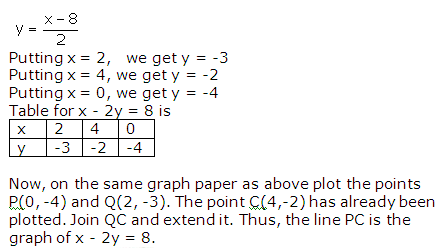
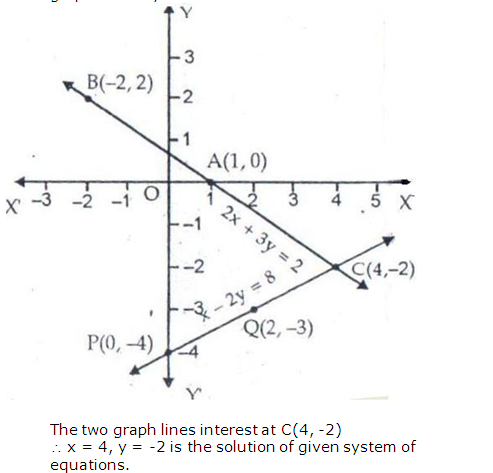 h3
h3
Read More:
- What is a Linear Equation
- Linear Equations In One Variable
- Linear Equations In Two Variables
- Graphical Method Of Solving Linear Equations In Two Variables
Question 2:
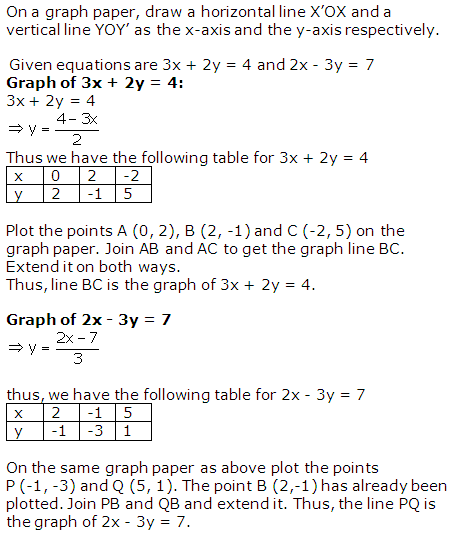
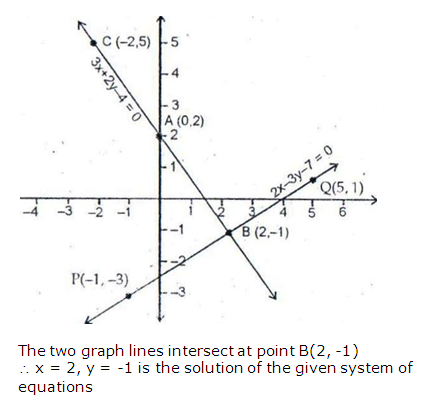
More Resources
Question 3:
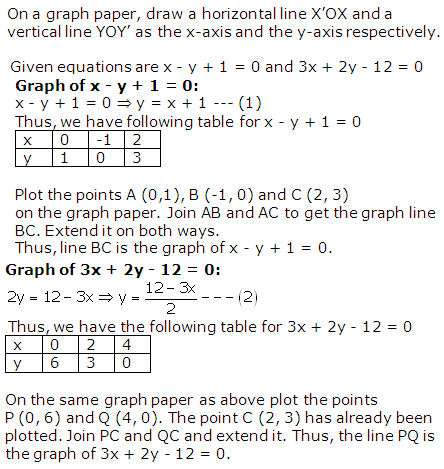
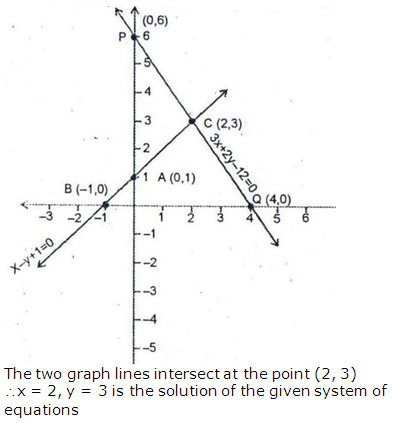
Question 4:
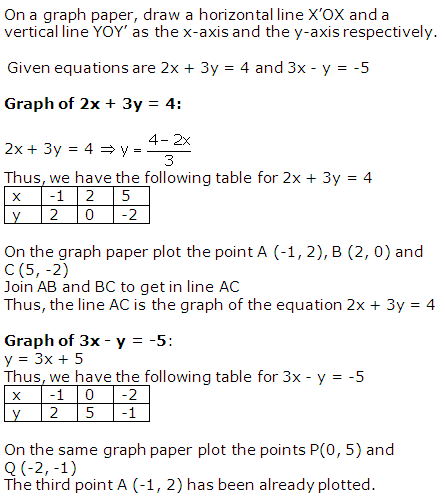

Question 5:


Question 6:
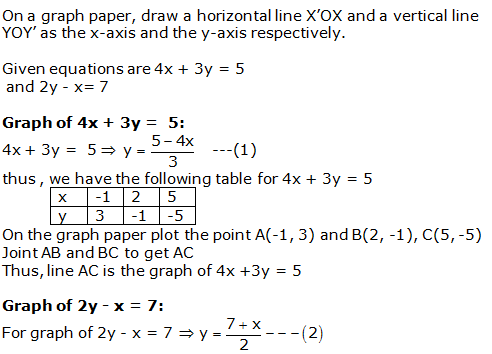
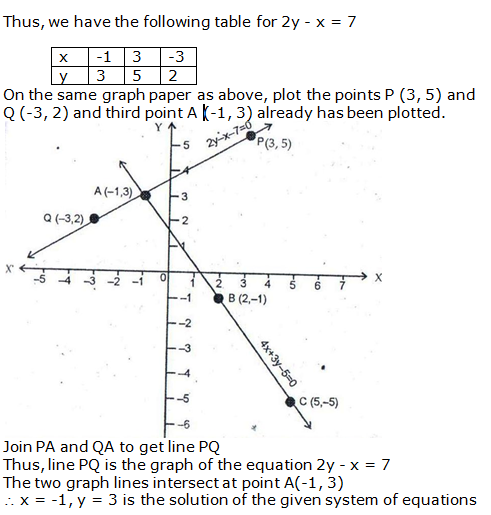
Question 7:
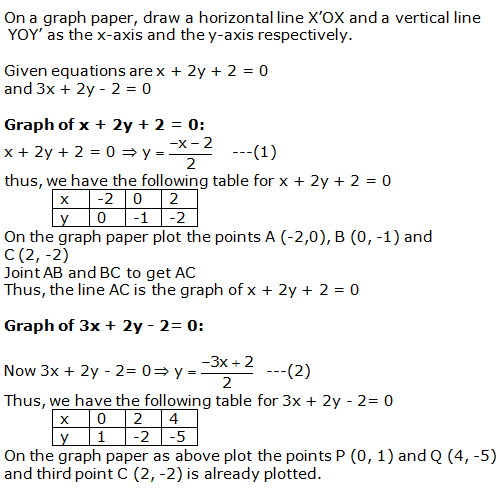
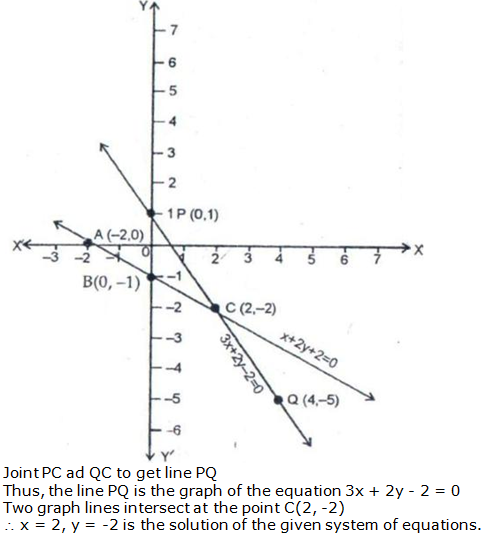
Question 8:


Question 9:

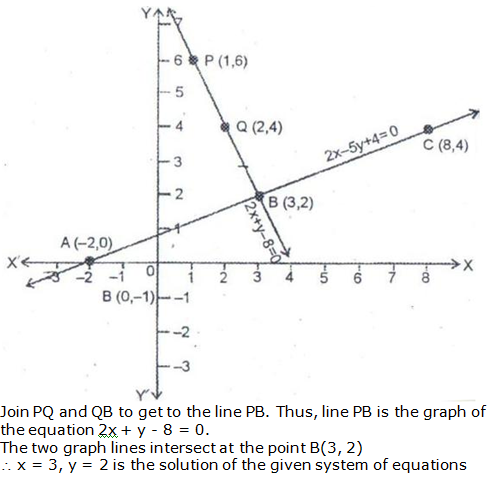
Question 10:
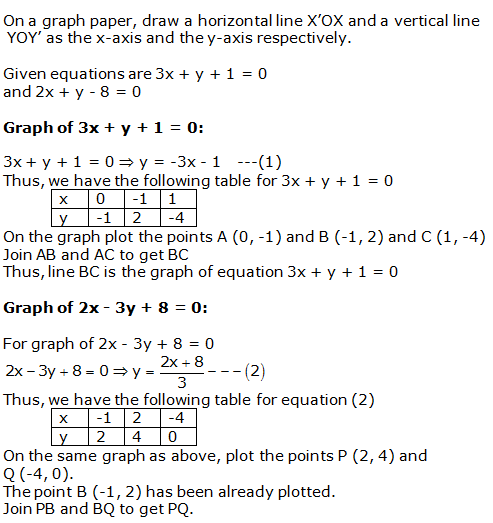
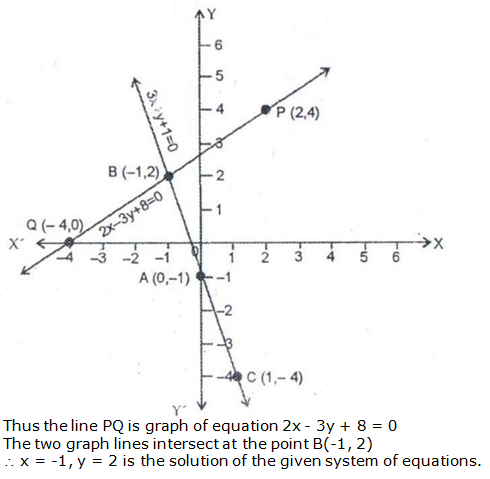
Question 11:
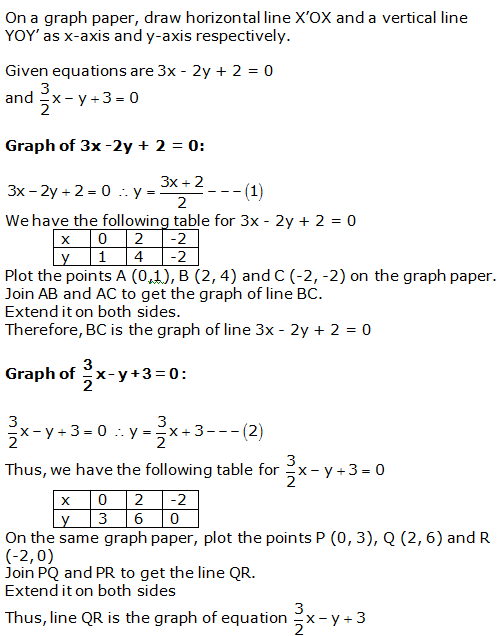
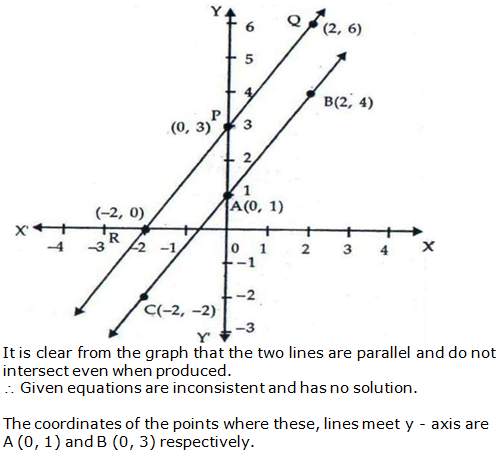
Question 12:

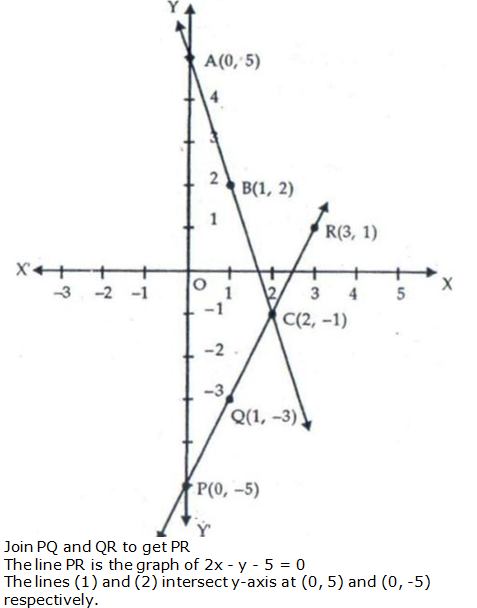
Question 13:

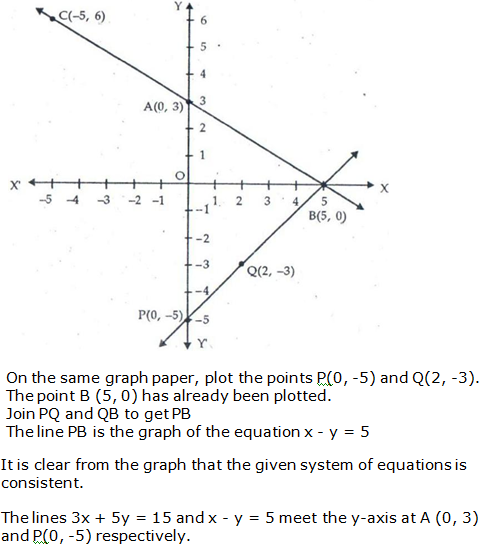
Question 14:
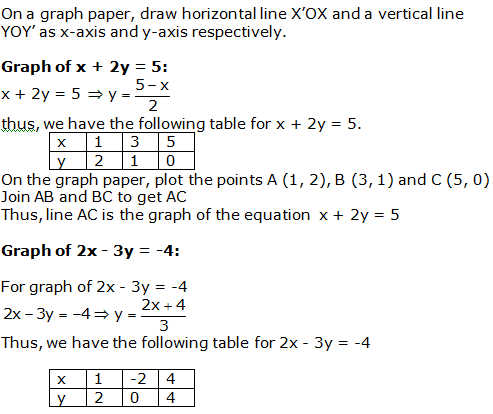

Question 15:

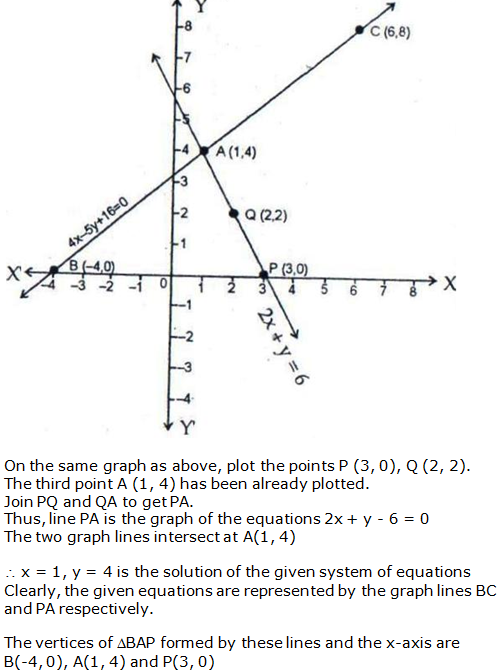
Question 16:


Question 17:

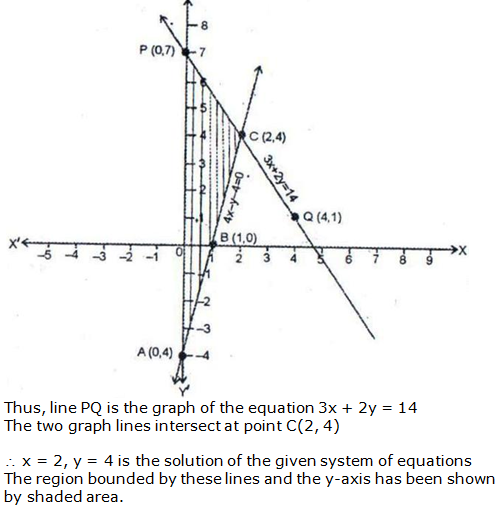
Question 18:
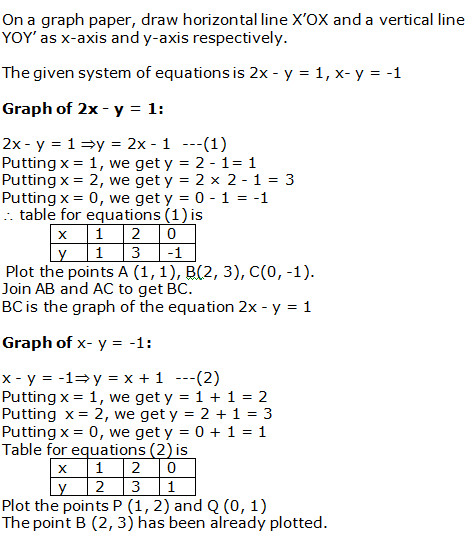
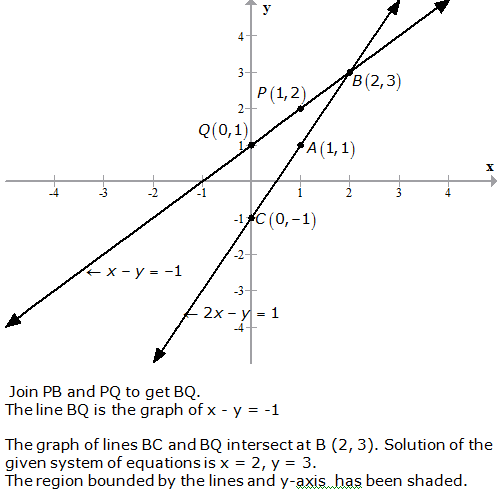
Question 19:
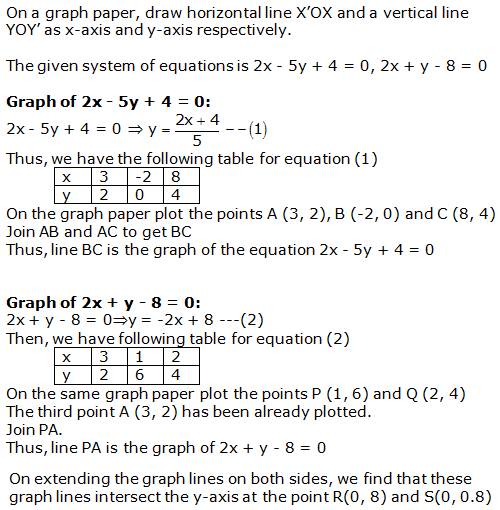
Question 20:
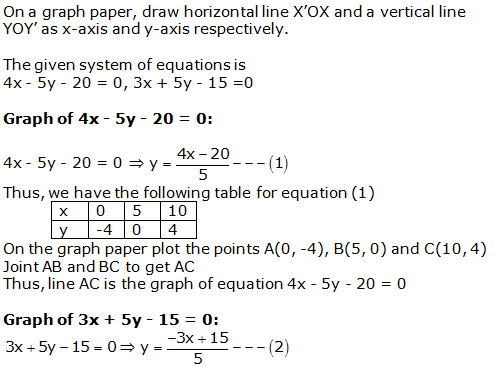
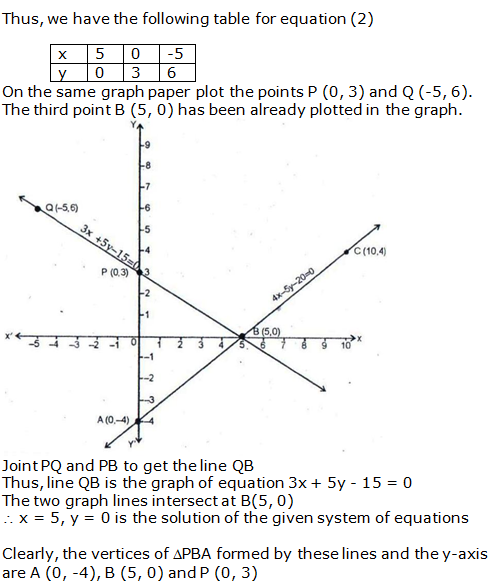
Question 21:


Question 22:

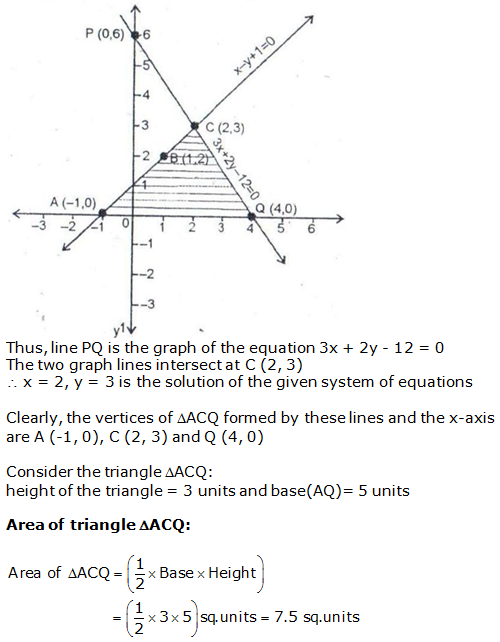
Question 23:
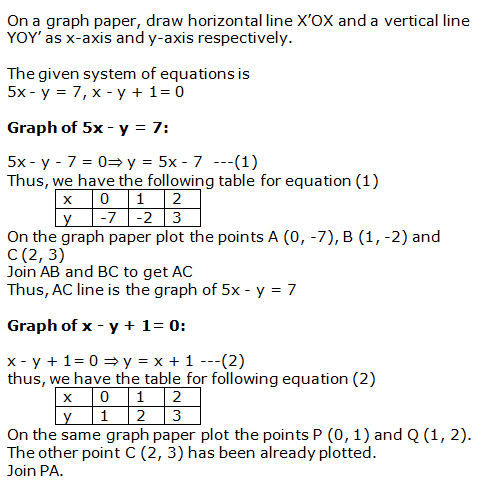
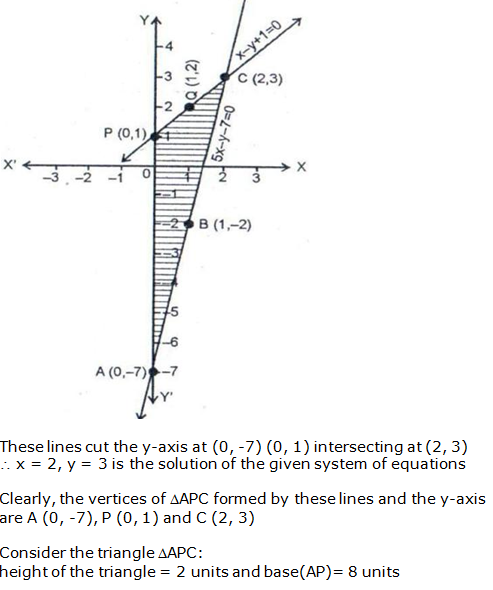
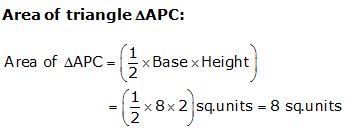
Question 24:
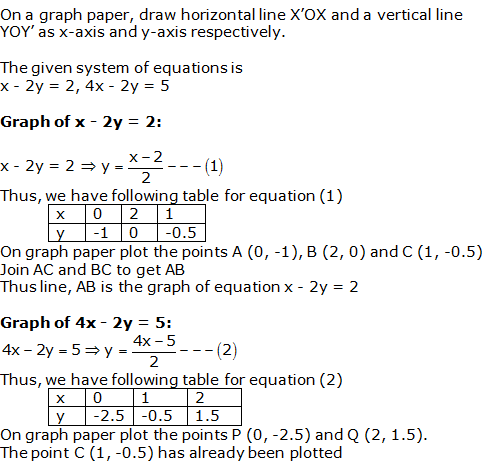
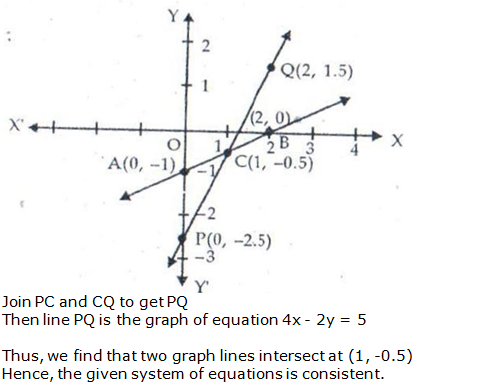
Question 25:


Question 26:


Question 27:

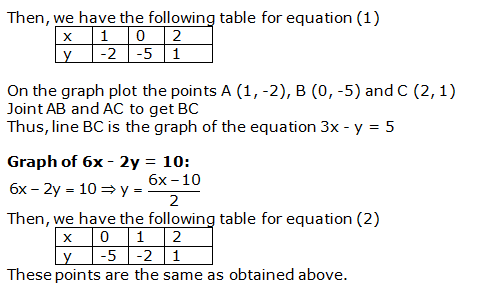
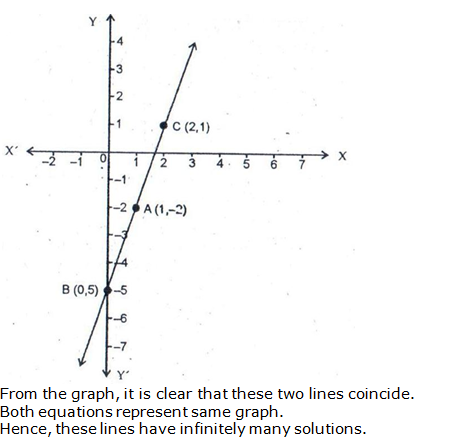
Question 28:
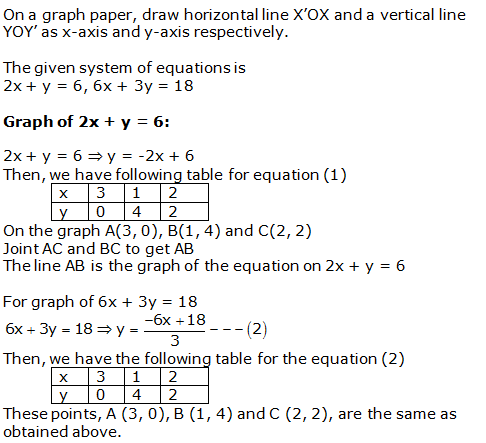

Exercise 3B
Question 1:
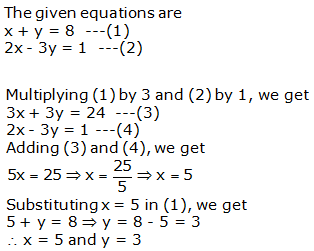
Question 2:
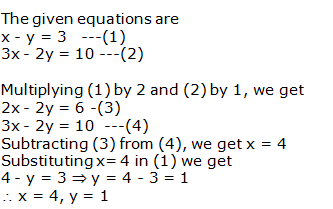
Question 3:
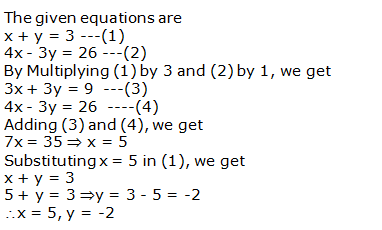
Question 4:
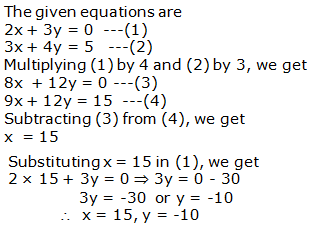
Question 5:
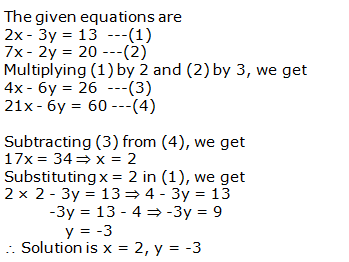
Question 6:
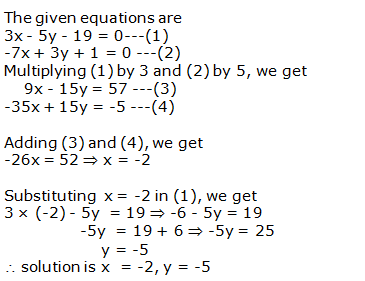
Question 7:
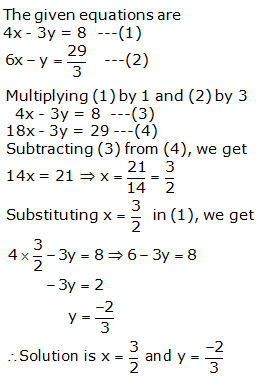
Question 8:

Question 9:
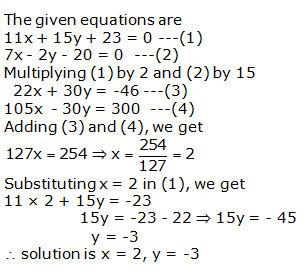
Question 10:
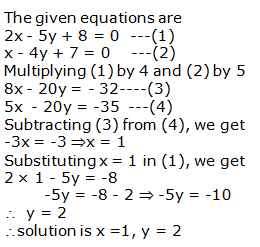
Question 11:

Question 12:

Question 13:
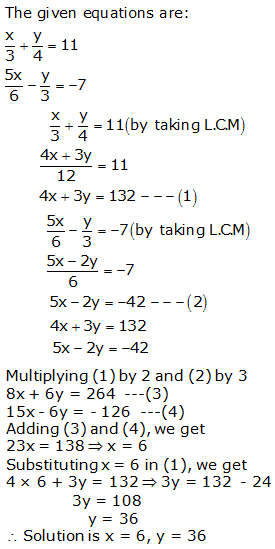
Question 14:
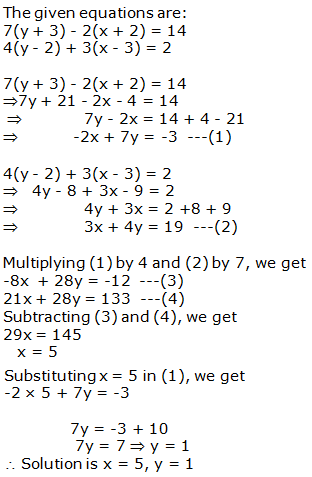
Question 15:

Question 16:
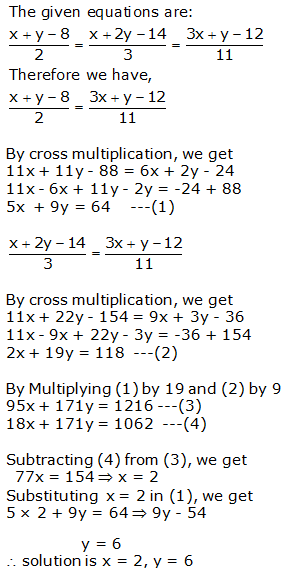
Question 17:
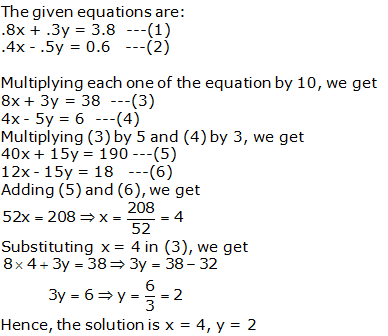
Question 18:

Question 19:

Question 20:
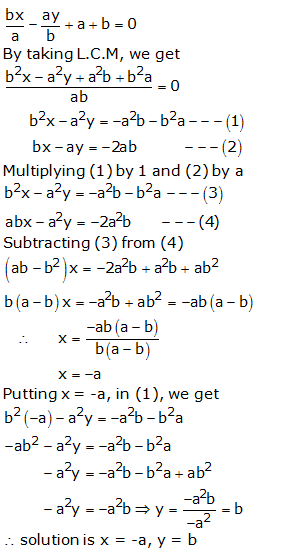
Question 21:
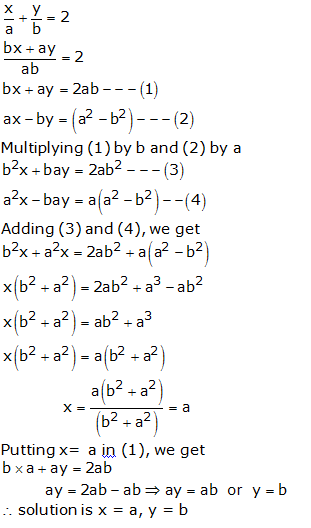
Question 22:
![]()
Taking L.C.M, we get
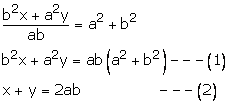
Multiplying (1) by 1 and (2) by

Subtracting (4) from (3), we get
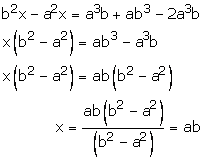
Substituting x = ab in (3), we get

Therefore solution is x = ab, y = ab
Question 23:
6(ax + by) = 3a + 2b
6ax + 6by = 3a + 2b —(1)
6(bx – ay) = 3b – 2a
6bx – 6ay = 3b- 2a —(2)
6ax + 6by = 3a + 2b —(1)
6bx – 6ay = 3b – 2a —(2)
Multiplying (1) by a and (2) by b

Adding (3) and (4), we get
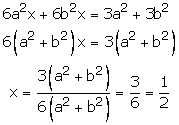
Substituting in (1), we get

Hence, the solution is
![]()
Question 24:
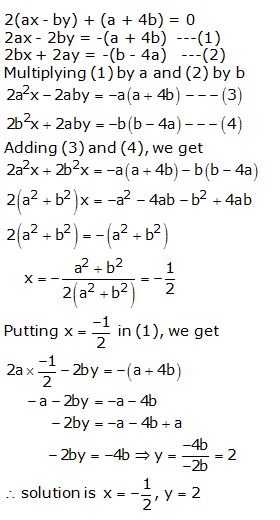
Question 25:
The given equations are
71x + 37y = 253 —(1)
37x + 71y = 287 —(2)
Adding (1) and (2)
108x + 108y = 540
108(x + y) = 540
![]() —-(3)
—-(3)
Subtracting (2) from (1)
34x – 34y = 253 – 287 = -34
34(x – y) = -34
![]() —(4)
—(4)
Adding (3) and (4)
2x = 5 – 1= 4
⇒ x = 2
Subtracting (4) from (3)
2y = 5 + 1 = 6
⇒ y = 3
Hence solution is x = 2, y = 3
Question 26:
37x + 43y = 123 —-(1)
43x + 37y = 117 —-(2)
Adding (1) and (2)
80x + 80y = 240
80(x + y) = 240
x + y = ![]() —-(3)
—-(3)
Subtracting (1) from (2),
6x – 6y = -6
6(x – y) = -6
![]() —-(4)
—-(4)
Adding (3) and (4)
2x = 3 – 1 = 2
⇒ x = 1
Subtracting (4) from (3),
2y = 3 + 1 = 4
⇒ y = 2
Hence solution is x = 1, y = 2
Question 27:
217x + 131y = 913 —(1)
131x + 217y = 827 —(2)
Adding (1) and (2), we get
348x + 348y = 1740
348(x + y) = 1740
x + y = 5 —-(3)
Subtracting (2) from (1), we get
86x – 86y = 86
86(x – y) = 86
x – y = 1 —(4)
Adding (3) and (4), we get
2x = 6
x = 3
putting x = 3 in (3), we get
3 + y = 5
y = 5 – 3 = 2
Hence solution is x = 3, y = 2
Question 28:
41x – 17y = 99 —(1)
17x – 41y = 75 —(2)
Adding (1) and (2), we get
58x – 58y = 174
58(x – y) = 174
x – y = 3 —(3)
subtracting (2) from (1), we get
24x + 24y = 24
24(x + y) = 24
x + y = 1 —(4)
Adding (3) and (4), we get
2x = 4 x = 2
Putting x = 2 in (3), we get
2 – y = 3
-y = 3 – 2 y = -1
Hence solution is x =2, y = -1
Exercise 3C
Question 1:
x + 2y + 1 = 0 —(1)
2x – 3y – 12 = 0 —(2)
By cross multiplication, we have
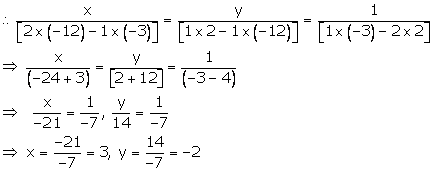
Hence, x = 3 and y = -2 is the solution
Question 2:
2x + 5y – 1 = 0 —(1)
2x + 3y – 3 = 0 —(2)
By cross multiplication we have
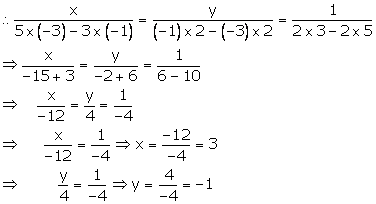
Hence the solution is x = 3, y = -1
Question 3:
3x – 2y + 3 = 0
4x + 3y – 47 = 0
By cross multiplication we have
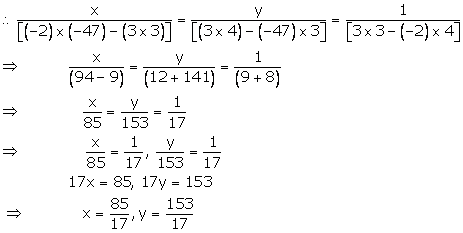
Hence the solution is x = 5, y = 9
Question 4:
6x – 5y – 16 = 0
7x – 13y + 10 = 0
By cross multiplication we have

Hence the solution is x = 6, y = 4
Question 5:
3x + 2y + 25 = 0
2x + y + 10 = 0
By cross multiplication, we have
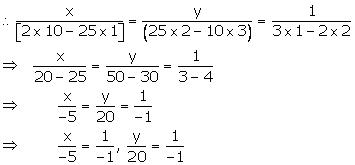
Hence the solution is x = 5, y = -20
Question 6:
2x + y – 35 = 0
3x + 4y – 65 = 0
By cross multiplication, we have

Question 7:
7x – 2y – 3 = 0
By cross multiplication, we have
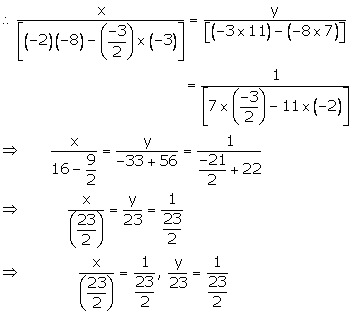
Hence x = 1, y = 2 is the solution
Question 8:

Question 9:
ax + by – (a – b) = 0
bx – ay – (a + b) = 0
By cross multiplication, we have
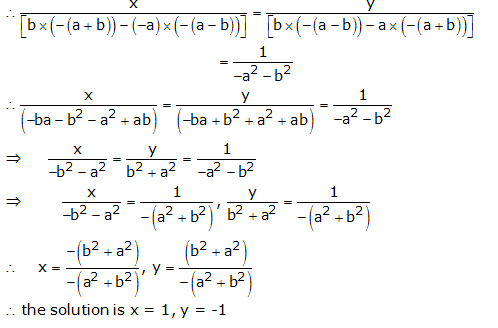
Question 10:
2ax + 3by – (a + 2b) = 0
3ax + 2by – (2a + b) = 0
By cross multiplication, we have
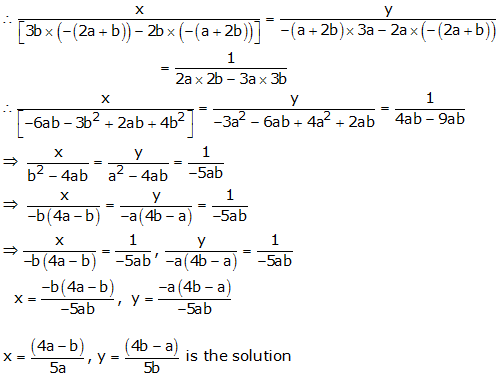
Question 11:

By cross multiplication, we have

Question 12:

By cross multiplication, we have
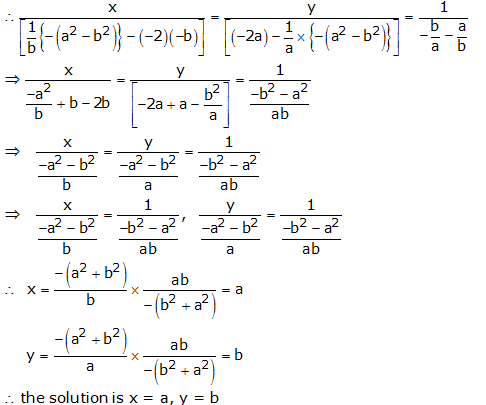
Question 13:

By cross multiplication we have
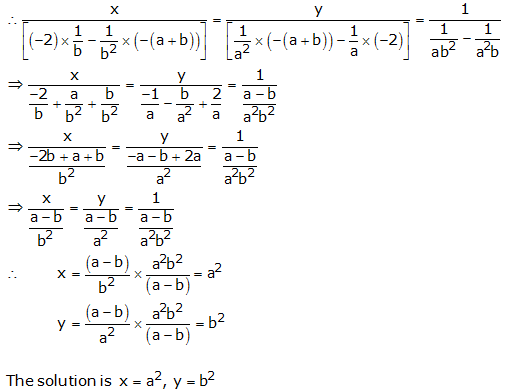
Question 14:

Taking
![]()
u + v – 7 = 0
2u + 3v – 17 = 0
By cross multiplication, we have
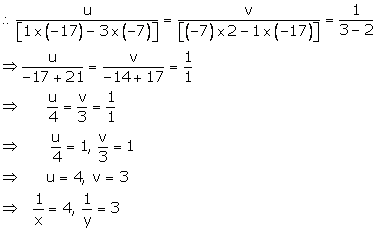
Hence the solution is
![]()
Question 15:
Let
![]()
in the equation
5u – 2v + 1 = 0
15u + 7v – 10 = 0
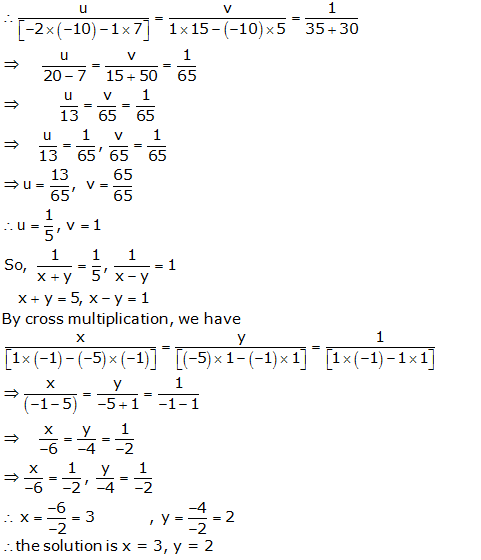
Question 16:
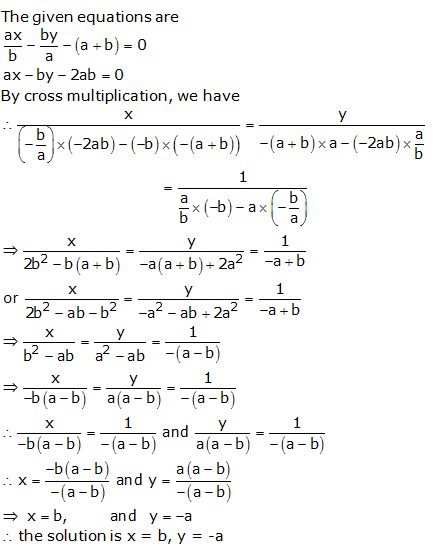
Exercise 3D
Question 1:
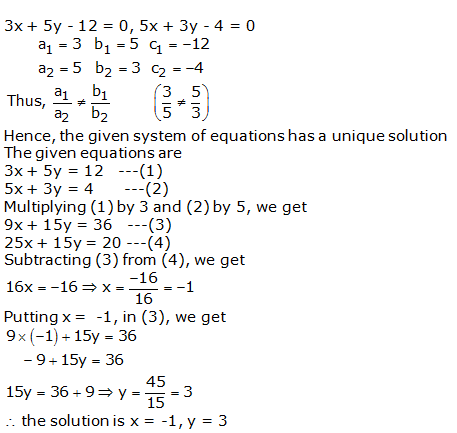
Question 2:
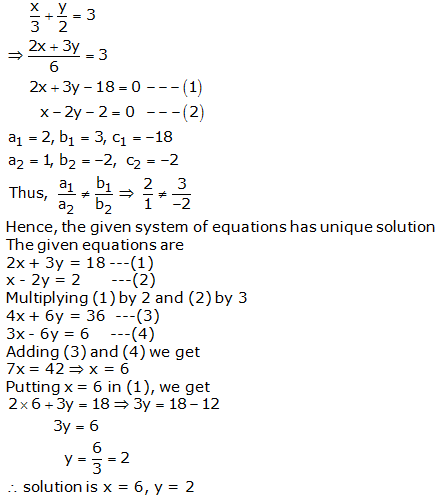
Question 3:
3x – 5y – 7 = 0
6x – 10y – 3 = 0

Hence the given system of equations is inconsistent
Question 4:
2x – 3y – 5 = 0, 6x – 9y – 15 = 0
These equations are of the form

Hence the given system of equations has infinitely many solutions
Question 5:
kx + 2y – 5 = 0
3x – 4y – 10 = 0
These equations are of the form
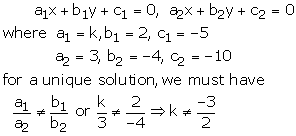
This happens when
\(k\neq \frac { -3 }{ 2 }\)
Thus, for all real value of k other that , the given system equations will have a unique solution
(ii) For no solution we must have
![]()

Hence, the given system of equations has no solution if \(k=\frac { -3 }{ 2 } \)
Question 6:
x + 2y – 5 = 0
3x + ky + 15 = 0
These equations are of the form of
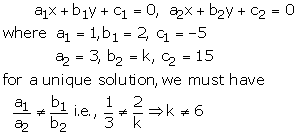
Thus for all real value of k other than 6, the given system of equation will have unique solution
(ii) For no solution we must have
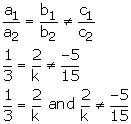
Therefore k = 6
Hence the given system will have no solution when k = 6.
Question 7:
x + 2y – 3 = 0, 5x + ky + 7 = 0
These equations are of the form
![]()
(i) For a unique solution we must have

Thus, for all real value of k other than 10
The given system of equation will have a unique solution.
(ii) For no solution we must have
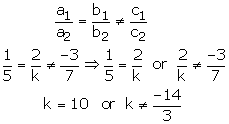
Hence the given system of equations has no solution if
![]()
For infinite number of solutions we must have

This is never possible since
![]()
There is no value of k for which system of equations has infinitely many solutions
Question 8:
8x + 5y – 9 = 0
kx + 10y – 15 = 0
These equations are of the form

Clearly, k = 16 also satisfies the condition
![]()
Hence, the given system will have no solution when k = 16.
Question 9:
kx + 3y – 3 = 0 —-(1)
12x + ky – 6 = 0 —(2)
![]()
These equations are of the form
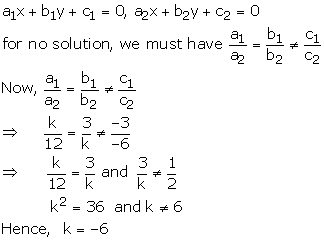
Hence, the given system will have no solution when k = -6
Question 10:
3x + y – 1 = 0
(2k – 1)x + (k – 1)y – (2k + 1) = 0
These equations are of the form
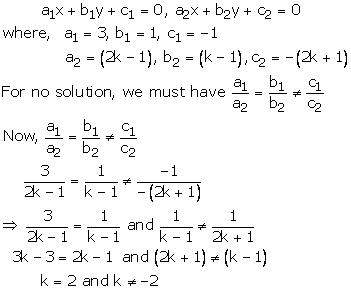
Thus,
![]()
Hence the given equation has no solution when k = 2
Question 11:
(3k + 1)x + 3y – 2 = 0
(k2 + 1)x + (k – 2)y – 5 = 0
these equations are of the form

Thus, k = -1 also satisfy the condition
![]()
Hence, the given system will have no solution when k = -1
Question 12:
The given equations are
3x – y – 5 = 0 —(1)
6x – 2y + k = 0—(2)

Equations (1) and (2) have no solution, if
![]()
Question 13:
kx + 2y – 5 = 0
3x + y – 1 = 0
These equations are of the form

Thus, for all real values of k other than 6, the given system of equations will have a unique solution
Question 14:
x – 2y – 3 = 0
3x + ky – 1 = 0
These equations are of the form of
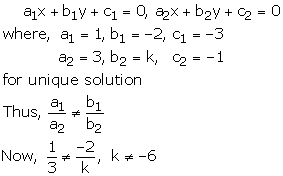
Thus, for all real value of k other than -6, the given system of equations will have a unique solution
Question 15:
kx + 3y – (k – 3) = 0
12x + ky – k = 0
These equations are of the form
Thus, for all real value of k other than , the given system of equations will have a unique solution
Question 16:
4x – 5y – k = 0, 2x – 3y – 12 = 0
These equations are of the form
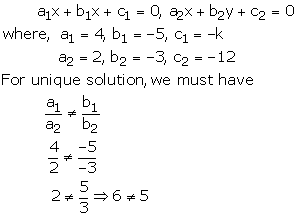
Thus, for all real value of k the given system of equations will have a unique solution
Question 17:
2x + 3y – 7 = 0
(k – 1)x + (k + 2)y – 3k = 0
These are of the form
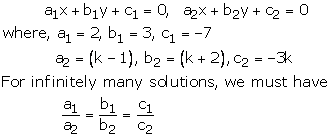
This hold only when

Now the following cases arises
Case : I

Case: II

Case III

For k = 7, there are infinitely many solutions of the given system of equations
Question 18:
2x + (k – 2)y – k = 0
6x + (2k – 1)y – (2k + 5) = 0
These are of the form

For infinite number of solutions, we have
![]()
This hold only when

Case (1)

Case (2)

Case (3)

Thus, for k = 5 there are infinitely many solutions
Question 19:
kx + 3y – (2k +1) = 0
2(k + 1)x + 9y – (7k + 1) = 0
These are of the form

For infinitely many solutions, we must have
![]()
This hold only when

Now, the following cases arise
Case – (1)

Case (2)

Case (3)
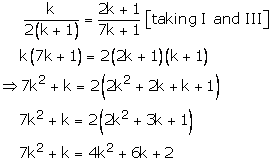
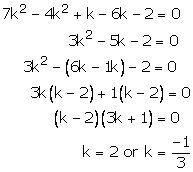
Thus, k = 2, is the common value for which there are infinitely many solutions
Question 20:
5x + 2y – 2k = 0
2(k +1)x + ky – (3k + 4) = 0
These are of the form

For infinitely many solutions, we must have
![]()
These hold only when

Case I



Thus, k = 4 is a common value for which there are infinitely by many solutions.
Question 21:
x + (k + 1)y – 5 = 0
(k + 1)x + 9y – (8k – 1) = 0
These are of the form

For infinitely many solutions, we must have
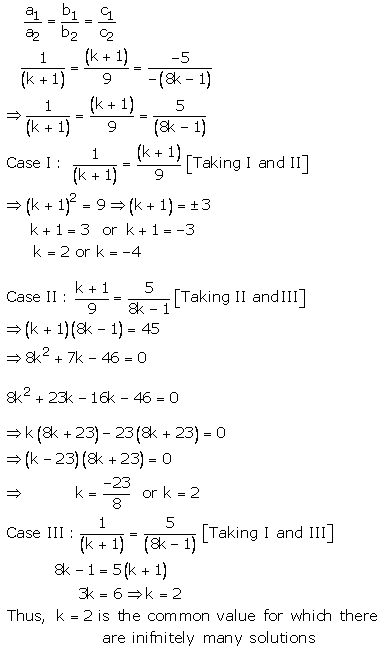
Question 22:
(k – 1)x – y – 5 = 0
(k + 1)x + (1 – k)y – (3k + 1) = 0
These are of the form

For infinitely many solution, we must now

k = 3 is common value for which the number of solutions is infinitely many
Question 23:
(a – 1)x + 3y – 2 = 0
6x + (1 – 2b)y – 6 = 0
These equations are of the form

For infinite many solutions, we must have
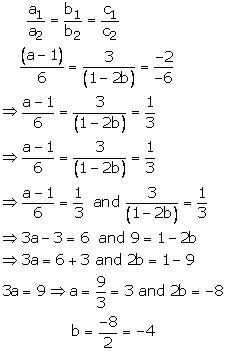
Hence a = 3 and b = -4
Question 24:
(2a – 1)x + 3y – 5 = 0
3x + (b – 1)y – 2 = 0
These equations are of the form

These holds only when
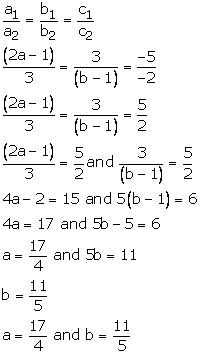
Question 25:
2x – 3y – 7 = 0
(a + b)x + (a + b – 3)y – (4a + b) = 0
These equation are of the form

For infinite number of solution
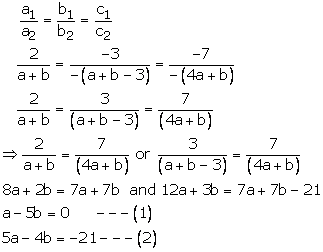
Putting a = 5b in (2), we get
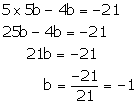
Putting b = -1 in (1), we get

Thus, a = -5, b = -1
Question 27:
The given equations are
2x + 3y = 7 —-(1)
a(x + y) – b(x – y) = 3a + b – 2 —(2)
Equation (2) is
ax + ay – bx + by = 3a + b – 2
(a – b)x + (a + b)y = 3a + b -2
Comparing with the equations

There are infinitely many solution
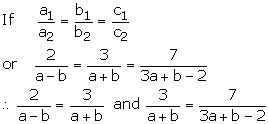
2a + 2b = 3a – 3b and 3(3a + b – 2) = 7(a + b)
-a = -5b and 9a + 3b – 6 = 7a + 7b
a = 5b and 9a – 7a + 3b – 7b = 6
or 2a – 4b = 6
or a – 2b = 3
thus equation in a, b are
a = 5b —(3)
a – 2b = 3 —(4)
putting a = 5b in (4)
5b – 2b = 3 or 3b = 3 Þ b = 1
Putting b = 1 in (3)
a = 5 and b = 1
Question 28:
We have 5x – 3y = 0 —(1)
2x + ky = 0 —(2)
Comparing the equation with
![]()
These equations have a non – zero solution if
![]()

Exercise 3E
Question 1:
Let the cost of 1 chair be Rs x and the cost of one table be Rs. y
The cost of 5 chairs and 4 tables = Rs(5x + 4y) = Rs. 2800
5x + 4y = 2800 —(1)
The cost of 4 chairs and 3 tables = Rs(4x + 3y) = Rs. 2170
4x + 3y = 2170 —(2)
Multiplying (1) by 3 and (2) by 4, we get
15x + 12y = 8400 —(3)
16x + 12y = 8680 —(4)
Subtracting (3) and (4), we get
x = 280
Putting value of x in (1), we get
5 × 280 + 4y = 2800
or 1400 + 4y = 2800
or 4y = 1400
\(y=\frac { 1400 }{ 4 } =350 \)
Thus, cost of 1 chair = Rs. 280 and cost of 1 table = Rs. 350
Question 2:
Let the cost of a pen and a pencil be Rs x and Rs y respectively
Cost of 37 pens and 53 pencils = Rs(37x + 53y) = Rs 820
37x + 53y = 820 —(1)
Cost of 53 pens and 37 pencils = Rs(53x + 37y) = Rs 980
53x + 37y = 980 —(2)
Adding (1) and (2), we get
90x + 90y = 1800
x + y = 20 —(3)
y = 20 – x
Putting value of y in (1), we get
37x + 53(20 – x) = 820
37x + 1060 – 53x = 820
16x = 240
\(x=\frac { 240 }{ 16} =15 \)
From (3), y = 20 – x = 20 – 15 = 5
x = 15, y = 5
Thus, cost of a pen = Rs 15 and cost of pencil = Rs 5
Question 3:
Let the number of 20 P and 25 P coins be x and y respectively
Total number of coins x + y = 50
i.e., x + y = 50 —(1)

Multiplying (1) by 5 and (2) by 1, we get
5x + 5y = 250 —(3)
4x + 5y = 230 —(4)
Subtracting (4) from (3), we get
x = 20
Putting x = 20 in (1),
y = 50 – x
= 50 – 20
= 30
Hence, number of 20 P coins = 20 and number of 25 P coins = 30
Question 4:
Let the two numbers be x and y respectively.
Given:
x + y = 137 —(1)
x – y = 43 —(2)
Adding (1) and (2), we get
2x = 180
\(y=\frac { 180 }{ 2} =90 \)
Putting x = 90 in (1), we get
90 + y = 137
y = 137 – 90
= 47
Hence, the two numbers are 90 and 47.
Question 5:
Let the first and second number be x and y respectively.
According to the question:
2x + 3y = 92 —(1)
4x – 7y = 2 —(2)
Multiplying (1) by 7 and (2) by 3, we get
14 x+ 21y = 644 —(3)
12x – 21y = 6 —(4)
Adding (3) and (4), we get
\(26x=650\\ x=\frac { 650 }{ 26 } =25 \)[/latex]
Putting x = 25 in (1), we get
2 × 25 + 3y = 92
50 + 3y = 92
3y = 92 – 50
\(y=\frac { 42 }{ 3 } =14 \)
y = 14
Question 6:
Let the first and second numbers be x and y respectively.
According to the question:
3x + y = 142 —(1)
4x – y = 138 —(2)
Adding (1) and (2), we get
\(7x=280\\x=\frac { 280 }{ 7 } =40 \)
Putting x = 40 in (1), we get
3 × 40 + y = 142
y = 142 – 120
y = 22
Hence, the first and second numbers are 40 and 22.
Question 7:
Let the greater number be x and smaller be y respectively.
According to the question:
2x – 45 = y
2x – y = 45 —(1)
and
2y – x = 21
-x + 2y = 21 —(2)
Multiplying (1) by 2 and (2) by 1
4x – 2y = 90 —(3)
-x + 2y = 21 —(4)
Adding (3) and (4), we get
3x = 111
\(x=\frac { 111 }{ 3 } =37 \)
Putting x = 37 in (1), we get
2 × 37 – y = 45
74 – y = 45
y = 29
Hence, the greater and the smaller numbers are 37 and 29.
Question 8:
Let the larger number be x and smaller be y respectively.
We know,
Dividend = Divisor × Quotient + Remainder
3x = y × 4 + 8
3x – 4y = 8 —(1)
And
5y = x × 3 + 5
-3x + 5y = 5 —(2)
Adding (1) and (2), we get
y = 13
putting y = 13 in (1)

Hence, the larger and smaller numbers are 20 and 13 respectively.
Question 9:
Let the required numbers be x and y respectively.
Then,

Therefore,
2x – y = -2 —(1)
11x – 5y = 24 —(2)
Multiplying (1) by 5 and (2) by 1
10x – 5y = -10 —(3)
11x – 5y = 24 —(4)
Subtracting (3) and (4) we get
x = 34
putting x = 34 in (1), we get
2 × 34 – y = -2
68 – y = -2
-y = -2 – 68
y = 70
Hence, the required numbers are 34 and 70.
Question 10:
Let the numbers be x and y respectively.
According to the question:
![]()
x – y = 14 —(1)
From (1), we get
x = 14 + y —(3)
putting x = 14 + y in (2), we get

Putting y = 9 in (1), we get
x – 9 = 14
x = 14 + 9 = 23
Hence the required numbers are 23 and 9
Question 11:
Let the ten’s digit be x and units digit be y respectively.
Then,
x + y = 12 —(1)
Let the ten’s digit of required number be x and its unit’s digit be y respectively
Required number = 10x + y
10x + y = 7(x + y)
10x + y = 7x + 7y
3x – 6y = 0 —(1)
Number found on reversing the digits = 10y + x
(10x + y) – 27 = 10y + x
10x – x + y – 10y = 27
9x – 9y = 27
(x – y) = 27
x – y = 3 —(2)
Multiplying (1) by 1 and (2) by 6
3x – 6y = 0 —(3)
6x – 6y = 18 —(4)
Subtracting (3) from (4), we get
\(3x=18\\ x=\frac { 18 }{ 3 } =6 \)
Putting x = 6 in (1), we get
3 × 6 – 6y = 0
18 – 6y = 0
\(-6y=-18\\ y=\frac { -18 }{ -6 } =3 \)
Number = 10x + y
= 10 × 6 + 3
= 60 + 3
= 63
Hence the number is 63.
Question 12:
Let the ten’s digit and unit’s digits of required number be x and y respectively.
Required number = 10x + y
Number obtained on reversing digits = 10y + x
According to the question:
10y + x × (10x + y) = 18
10y + x – 10x – y = 18
9y – 9x = 18
y – x = 2 —-(2)
Adding (1) and (2), we get
\(2y=14\\ y=\frac { 14 }{ 2 } =7 \)
Putting y = 7 in (1), we get
x + 7 = 12
x = 5
Number = 10x + y
= 10 × 5 + 7
= 50 + 7
= 57
Hence, the number is 57.
Question 13:
Let the ten’s digit and unit’s digits of required number be x and y respectively.
Then,
x + y = 15 —(1)
Required number = 10x + y
Number obtained by interchanging the digits = 10y + x
10y + x × (10x + y) = 9
10y + x – 10x – y = 9
9y – 9x = 9

Add (1) and (2), we get
\(2y=16\\ y=\frac { 16 }{ 2 } =8 \)
Putting y = 8 in (1), we get
x + 8 = 15
x = 15 – 8 = 7
Required number = 10x + y
= 10 × 7 + 8
= 70 + 8
= 78
Hence the required number is 78.
Question 14:
Let the ten’s and unit’s of required number be x and y respectively.
Then, required number =10x + y
According to the given question:
10x + y = 4(x + y) + 3
10x + y = 4x + 4y + 3
6x – 3y = 3
2x – y = 1 —(1)
And
10x + y + 18 = 10y + x
9x – 9y = -18
![]()
x – y = -2 —(2)
Subtracting (2) from (1), we get
x = 3
Putting x = 3 in (1), we get
2 × 3 – y = 1
y = 6 – 1 = 5
x = 3, y = 5
Required number = 10x + y
= 10 × 3 + 5
= 30 + 5
= 35
Hence, required number is 35.
Question 15:
Let the ten’s digit and unit’s digit of required number be x and y respectively.
We know,
Dividend = (divisor × quotient) + remainder
According to the given questiion:
10x + y = 6 × (x + y) + 0
10x – 6x + y – 6y = 0
4x – 5y = 0 —(1)
Number obtained by reversing the digits is 10y + x
10x + y – 9 = 10y + x
9x – 9y = 9
9(x – y) = 9
(x – y) = 1 —(2)
Multiplying (1) by 1 and (2) by 5, we get
4x – 5y = 0 —(3)
5x – 5y = 5 —(4)
Subtracting (3) from (4), we get
x = 5
Putting x = 5 in (1), we get

x =5 and y = 4
Hence, required number is 54.
Question 16:
Let the ten’s and unit’s digits of the required number be x and y respectively.
Then, xy = 35
Required number = 10x + y
Also,
(10x + y) + 18 = 10y + x
9x – 9y = -18
9(y – x) = 18 —(1)
y – x = 2
Now,

Adding (1) and (2),
2y = 12 + 2 = 14
y = 7
Putting y = 7 in (1),
7 – x = 2
x = 5
Hence, the required number = 5 × 10 + 7
= 57
Question 17:
Let the ten’s and units digit of the required number be x and y respectively.
Then, xy = 14
Required number = 10x + y
Number obtained on reversing the digits = 10y + x
Also,
(10x + y) + 45 = 10y + x
9(y – x) = 45
y – x = 5 —(1)
Now,
![]()

y + x = 9 —(2) (digits cannot be negative, hence -9 is not possible)
On adding (1) and (2), we get
2y = 14
y = 7
Putting y = 7 in (2), we get
7 + x = 9
x = (9 – 7) = 2
x = 2 and y = 7
Hence, the required number is = 2 × 10 + 7
= 27
Question 18:
Let the ten’s and unit’s digits of the required number be x and y respectively.
Then, xy = 18
Required number = 10x + y
Number obtained on reversing its digits = 10y + x
(10x + y) – 63 = (10y + x)
9x – 9y = 63
x – y = 7 —(1)
Now,
![]()

Adding (1) and (2), we get
![]()
Putting x = 9 in (1), we get
9 – y = 7
y = 9 – 7
y = 2
x = 9, y = 2
Hence, the required number = 9 × 10 + 2
= 92.
Question 19:
Let the ten’s digit be x and the unit digit be y respectively.
Then, required number = 10x + y
According to the given question:
10x + y = 4(x + y)
6x – 3y = 0
2x – y = 0 —(1)
And
10x + y = 2xy —(2)
Putting y = 2x from (1) in (2), we get
10x + 2x = 4x2 ⇒ 12x – 4x2 = 0 ⇒ 4x(3 – x) = 0 ⇒ x = 3
Putting x = 3 in (1), we get
2 × 3 – y = 0
y = 6
Hence, the required number = 3 × 10 + 6
= 36.
Question 20:
Let the numerator and denominator of fraction be x and y respectively.
According to the question:
x + y = 8 —(1)
And

Multiplying (1) be 3 and (2) by 1
3x + 3y = 24 —(3)
4x – 3y = -3 —(4)
Add (3) and (4), we get
\(7x=21\\ x=\frac { 21 }{ 7 } =3 \)
Putting x = 3 in (1), we get
3 + y= 8
y = 8 – 3
y = 5
x = 3, y = 5
Hence, the fraction is \(\frac { x }{ y } =\frac { 3 }{ 5 } \)
Question 21:
Let numerator and denominator be x and y respectively.
Sum of numerator and denominator = x + y
3 less than 2 times y = 2y – 3
x + y =2y – 3
or x – y = -3 —(1)
When 1 is decreased from numerator and denominator, the fraction becomes:
![]()
2(x – 1) = y – 1
or 2x – 2 = y – 1
or 2x – y = 1 —(2)
Subtracting (1) from (2), we get
x = 1 + 3 = 4
Putting x = 4 in (1), we get
y = x + 3
= 4 + 3
= 7
the fraction is \(\frac { x }{ y } =\frac { 4 }{ 7 } \)
Question 22:
Let the numerator and denominator be x and y respectively.
Then the fraction is \(\frac { x }{ y } \)

Subtracting (1) from (2), we get
x = 15
Putting x = 15 in (1), we get
2 × 15 – y = 4
30 – y = 4
y = 26
x = 15 and y = 26
Hence the given fraction is \(\frac { 15 }{ 26 } \)
Question 23:
Let the numerator and denominator be x and y respectively.
Then the fraction is \(\frac { x }{ y } \).
According to the given question:
y = x + 11
y – x = 11 —(1)
and
![]()
-3y + 4x = -8 —(2)
Multiplying (1) by 4 and (2) by 1
4y – 4x = 44 —(3)
-3y + 4x = -8 —(4)
Adding (3) and (4), we get
y = 36
Putting y = 36 in (1), we get
y – x = 11
36 – x = 11
x = 25
x = 25, y = 36
Hence the fraction is \(\frac { 25 }{ 36 } \)
Question 24:
Let the numerator and denominator be x and y respectively.
Then the fraction is \(\frac { x }{ y } \).

Subtracting (1) from (2), we get
x = 3
Putting x = 3 in (1), we get
2 × 3 – 4
-y = -4 -6
y = 10
x = 3 and y = 10
Hence the fraction is \(\frac { 3 }{ 10 } \)
Question 25:
Let the fraction be \(\frac { x }{ y } \).
When 2 is added to both the numerator and the denominator, the fraction becomes:
![]()
3x – y = -4 —(1)
When 3 is added both to the numerator and the denominator, the fractions becomes:
![]()
5x – 2y = -9 —-(2)
Multiplying (1) by 2 and (2) by 1, we get
6x – 2y = -8 —(3)
5x – 2y = -9 —(4)
Subtracting (4) from (3), we get
x = 1
Putting x = 1 in (1),
3 × 1 – y = 4
y = 7
Required fraction is \(\frac { 1 }{ 7 } \)
Question 26:
Let the two numbers be x and y respectively.
According to the given question:
x + y = 16 —(1)
And
![]() —(2)
—(2)
From (2),
![]()
xy = 48
We know,

Adding (1) and (3), we get
2x = 24
x = 12
Putting x = 12 in (1),
y = 16 – x
= 16 – 12
= 4
The required numbers are 12 and 4.
Question 27:
Let the present ages of the man and his son be x years and y years respectively.
Then,
Two years ago:
(x – 2) = 5(y – 2)
x – 2 = 5y – 10
x – 5y = -8 —(1)
Two years later:
(x + 2) = 3(y + 2) + 8
x + 2 = 3y + 6 + 8
x – 3y = 12 —(2)
Subtracting (2) from (1), we get
-2y = -20
y = 10
Putting y = 10 in (1), we get
x – 5 × 10 = -8
x – 50 = -8
x = 42
Hence the present ages of the man and the son are 42 years and 10 respectively.
Question 28:
Let the present ages of A and B be x and y respectively.
Five years ago:
(x – 5) = 3(y – 5)
x – 5 = 3y – 15
x – 3y = -10 —(1)
Ten years later:
(x + 10) = 2(y + 10)
x + 10 = 2y + 20
x – 2y = 10 —(2)
Subtracting (2) from (1), we get
y = 20
Putting y = 20 in (1), we get
x – 3y = -10
x – 3 × 20 = -10
x = -10 + 60 = 50
x = 50, y = 20
Hence, present ages of A and B are 50 years and 20 years respectively.
Question 29:
Let the present ages of woman and daughter be x and y respectively.
Then,
Their present ages:
x = 3y + 3
x – 3y = 3 —(1)
Three years later:
(x + 3) = 2(y + 3) + 10
x + 3 = 2y + 6 + 10
x – 2y = 13 —(2)
Subtracting (2) from (1), we get
y = 10
Putting y = 10 in (1), we get
x – 3 × 10 = 3
x = 33
x = 33, y = 10
Hence, present ages of woman and daughter are 33 and 10 years.
Question 30:
Let the present ages of the mother and her son be x and y respectively.
According to the given question:
x + 2y = 70 —(1)
and
2x + y = 95 —(2)
Multiplying (1) by 1 and (2) by 2, we get
x + 2y = 70 —(3)
4x + 2y = 190 —(4)
Subtracting (3) from (4), we get
\(3x=120\\ y=\frac { 120 }{ 3 } =40 \)
Putting x = 40 in (1), we get
40 + 2y = 70
2y = 30
y = 15
x = 40, y = 15
Hence, the ages of the mother and the son are 40 years and 15 years respectively.
Question 31:
Let the present age of the man and the sum of the ages of the two sons be x and y respectively.
We are given x = 3y —(1)
After 5 years the age of man = x + 5
And age of each son is increased by 5 years
Age of two sons after 5 years = y + 5 + 5 = y + 10
Now,
x + 5 = 2(y + 10)
or x + 5 = 2y + 10
x – 2y = 15 —(2)
Putting x = 3y in (2)
3y – 2y = 15
y = 15
Putting y = 15 in (1),
x = 3 × 15 = 45
Age of the man = 45 years.
Question 32:
Let the present age of the man and his son be x and y respectively.
Ten years later:
(x + 10) = 2(y + 10)
x + 10 = 2y + 20
x – 2y = 10 —(1)
Ten years ago:
(x – 10) = 4(y – 10)
x – 10 = 4y – 40
x – 4y = – 30 —(2)
Subtracting (1) from (2), we get
-2y = -40
y = 20 years
Putting y = 20 in (1), we get
x – 2 × 20 = 10
x = 50
x = 50 years, y = 20 years
Hence, present ages of the man and his son are 50 years and 20 years respectively.
Question 33:
Let the monthly income of A and B be Rs. 5x and Rs. 4x respectively and let their expenditures be Rs. 7y and Rs. 5y respectively.
Then,
5x – 7y = 3000 —(1)
4x – 5y = 3000 —(2)
Multiplying (1) by 5 and (2) by 7 we get
25x – 35y = 15000 —(3)
28x – 35y = 21000 —(4)
Subtracting (3) from (4), we get
3x = 6000
x = 2000
Putting x = 2000 in (1), we get
5 × 2000 – 7y = 3000
-7y = 3000 – 10000
\(y=\frac { -7000 }{ -7 } =1000 \)
x = 2000, y = 1000
Income of A = 5x = 5 × 2000 = Rs. 10000
Income of B = 4x = 4 × 2000 = Rs. 8000
Question 34:
Let Rs. x and Rs. y be the CP of a chair and table respectively
If profit is 25%, then SP of chair =![]()
If profit is 10%, then SP of the table =![]()
SP of a chair and table = Rs. 760

Further , If profit is 10%, then SP of a chair =![]() \(Rs\frac { 110 }{ 100 } x \)
\(Rs\frac { 110 }{ 100 } x \)
If profit is 25%, then SP of a table =![]() \(Rs\frac { 125 }{ 100 } y \)
\(Rs\frac { 125 }{ 100 } y \)
SP of a chair and table = Rs. 767.50

Adding (1) and (2),

Subtracting (2) from (1)

Adding (3) and (4),

Subtracting (4) from (3)

Hence, CP of a chair is Rs 300 and CP of table is Rs 350.
Question 35:
Let the CP of TV and fridge be Rs x and Rs y respectively.

Further,
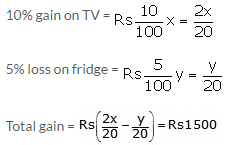
2x – y = 30000 —(2)
Multiplying (2) by 2 and (1) by 1, we get
4x – 2y = 60000 —(3)
x + 2y = 65000 —(4)
Adding (3) and (4), we get
5x = 125000
x = 25000
Putting x = 25000 in (1), we get
25000 + 2y = 65000
2y = 40000
y = 20000
The cost of TV = Rs. 25000 and cost of fridge = Rs. 20000
Question 36:
Let the amounts invested at 12% and 10% be Rs x and Rs y respectively.
Then,
First case:
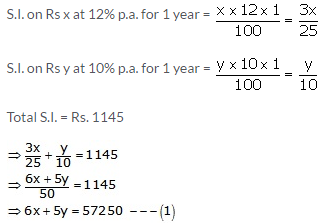
Second case:
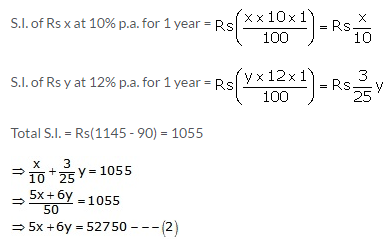
Multiplying (1) by 6 and (2) by 5, we get
36x + 30y = 343500 —(3)
25x + 30y = 263750 —(4)
Subtracting (4) from (3), we get
\(11x=79750\\ x=\frac { 79750 }{ 11 } =7250 \)
Putting x = 7250 in (1), we get
6 × 7250 + 5y = 57250
43500 + 5y = 57250
5y = 13750
y = 2750
x = 7250, y = 2750
Hence, amount invested at 12% = Rs 7250
And amount invested at 10% = Rs 2750
Question 37:
Let the number of student in class room A and B be x and y respectively.
When 10 students are transferred from A to B:
x – 10 = y + 10
x – y = 20 —(1)
When 20 students are transferred from B to A:
2(y – 20) = x + 20
2y – 40 = x + 20
-x + 2y = 60 —(2)
Adding (1) and (2), we get
y = 80
Putting y = 80 in (1), we get
x – 80 = 20
x = 100
Hence, number of students of A and B are 100 and 80 respectively.
Question 38:
Let P and Q be the cars starting from A and B respectively and let their speeds be x km/hr and y km/hr respectively.
Case- I
When the cars P and Q move in the same direction.
Distance covered by the car P in 7 hours = 7x km
Distance covered by the car Q in 7 hours = 7y km
Let the cars meet at point M.

AM = 7x km and BM = 7y km
AM – BM = AB
7x – 7y = 70
7(x – y) = 70
x – y = 10 —-(1)
Case II
When the cars P and Q move in opposite directions.
Distance covered by P in 1 hour = x km
Distance covered by Q in 1 hour = y km
In this case let the cars meet at a point N.
![]()
AN = x km and BN = y km
AN + BN = AB
x + y = 70 —(2)
Adding (1) and (2), we get
2x = 80
x = 40
Putting x = 40 in (1), we get
40 – y = 10
y = (40 – 10) = 30
x = 40, y = 30
Hence, the speeds of these cars are 40 km/ hr and 30 km/ hr respectively.
Question 39:
Let the original speed be x km/h and time taken be y hours
Then, length of journey = xy km
Case I:
Speed = (x + 5)km/h and time taken = (y – 3)hour
Distance covered = (x + 5)(y – 3)km
(x + 5) (y – 3) = xy
xy + 5y -3x -15 = xy
5y – 3x = 15 —(1)
Case II:
Speed (x – 4)km/hr and time taken = (y + 3)hours
Distance covered = (x – 4)(y + 3) km
(x – 4)(y + 3) = xy
xy -4y + 3x -12 = xy
3x – 4y = 12 —(2)
Multiplying (1) by 4 and (2) by 5, we get
20y × 12x = 60 —(3)
-20y + 15x = 60 —(4)
Adding (3) and (4), we get
3x = 120
or x = 40
Putting x = 40 in (1), we get
5y – 3 × 40 = 15
5y = 135
y = 27
Hence, length of the journey is (40 × 27) km = 1080 km
Question 40:
Let the speed of train and car be x km/hr and y km/hr respectively.
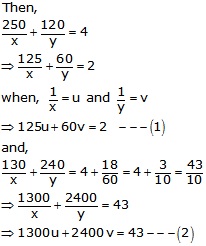
Multiplying (1) by 40 and (2) by 1, we get
5000u + 2400v = 80 —(3)
1300u + 2400v = 43 —(4)
subtracting (4) from (3), we get
\(3700u=37\\ u=\frac { 1 }{ 100 } \)
Putting \(u=\frac { 1 }{ 100 } \) in (1), we get

Hence, speeds of the train and the car are 100km/hr and 80 km/hr respectively.
Question 41:
Let the speed of the boat in still water be x km/hr and speed of the stream be y km/hr.
Then,
Speed upstream = (x – y)km/hr
Speed downstream = (x + y) km/hr
Time taken to cover 12 km upstream = \(\frac { 12 }{ x-y } hrs \)
Time taken to cover 40 km downstream = \(\frac { 40 }{ x+y } hrs \)
Total time taken = 8hrs
![]()
Again, time taken to cover 16 km upstream = \(\frac { 16 }{ x-y } \)
Time taken to taken to cover 32 km downstream = \(\frac { 32 }{ x+y } \)
Total time taken = 8hrs
![]()
Putting ![]()
12u + 40v = 8
3u + 10v = 2 —(1)
and
16u + 32v = 8
2u + 4v = 1 —(2)
Multiplying (1) by 4 and (2) by 10, we get
12u + 40v = 8 —(3)
20u + 40v = 10 —(4)
Subtracting (3) from (4), we get
\(8u=2\\ u=\frac { 1 }{ 4 } \)
Putting \(u=\frac { 1 }{ 4 } \) in (3), we get

On adding (5) and (6), we get
2x = 12
x = 6
Putting x = 6 in (6) we get
6 + y = 8
y = 8 – 6 = 2
x = 6, y = 2
Hence, the speed of the boat in still water = 6 km/hr and speed of the stream = 2km/hr
Question 42:
Let the fixed charges of taxi per day be Rs x and charges for travelling for 1km be Rs y.
For travelling 110 km, he pays
Rs x + Rs 110y = Rs 1130
x + 110y = 1130 —(1)
For travelling 200 km, he pays
Rs x + Rs 200y = Rs 1850
x + 200y = 1850 —(2)
Subtracting (1) from (2), we get
\(90y=1850-1130=720\\ y=\frac { 720 }{ 90 } =8 \)
Putting y = 8 in (1),
x + 110 × 8 = 1130
x = 1130 – 880 = 250
Hence, fixed charges = Rs 250
And charges for travelling 1 km = Rs 8
Question 43:
Let the fixed hostel charges be Rs x and food charges per day be Rs y respectively.
For student A:
Student takes food for 25days and he has to pay: Rs 3500
Rs x + Rs 25y = Rs 3500
x + 25y = 3500 —(1)
For student B:
Student takes food for 28days and he has to pay: Rs 3800
Rs x + Rs 28y = Rs 3800
or x + 28y = 3800 —(2)
Subtracting (1) from (2), we get
3y = 3800 – 3500
3y= 300
y = 100
Putting y = 100 in (1),
x + 25 × 100 = 3500
or x = 3500 – 2500
or x = 1000
Thus, fixed charges for hostel = Rs 1000 and
Charges for food per day = Rs 100
Question 44:
Let the length = x meters and breadth = y meters
Then,
x = y + 3
x – y = 3 —-(1)
Also,
(x + 3)(y – 2) = xy
3y – 2x = 6 —-(2)
Multiplying (1) by 2 and (2) by 1
-2y + 2x = 6 —(3)
3y – 2x = 6 —(4)
Adding (3) and (4), we get
y = 12
Putting y = 12 in (1), we get
x – 12 = 3
x = 15
x = 15, y = 12
Hence length = 15 metres and breadth = 12 metres
Question 45:
Let the length of a rectangle be x meters and breadth be y meters.
Then, area = xy sq.m
Now,
xy – (x – 5)(y + 3) = 8
xy × [xy × 5y + 3x -15] = 8
xy × xy + 5y × 3x + 15 = 8
3x – 5y = 7 —(1)
And
(x + 3)(y + 2) – xy = 74
xy + 3y +2x + 6 × xy = 74
2x + 3y = 68 —(2)
Multiplying (1) by 3 and (2) by 5, we get
9x – 15y = 21 —(3)
10x + 15y = 340 —(4)
Adding (3) and (4), we get
![]()
Putting x = 19 in (3) we get
![]()
x = 19 meters, y = 10 meters
Hence, length = 19m and breadth = 10m
Question 46:
Let man’s 1 day’s work be \(\frac { 1 }{ x } \) and 1 boy’s day’s work be \(\frac { 1 }{ y } \)
Also let \(\frac { 1 }{ x } =u \) and \(\frac { 1 }{ y } =v \)

Multiplying (1) by 6 and (2) by 5 we get

Subtracting (3) from (4), we get

Putting \(u=\frac { 1 }{ 18 } \) in (1), we get
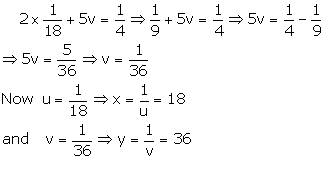
x = 18, y = 36
The man will finish the work in 18 days and the boy will finish the work in 36 days when they work alone.
Question 47:
∠A +∠B + ∠C = 180◦
x + 3x + y = 180
4x + y = 180 —(1)
Also,
3y – 5x = 30
-5x + 3y = 30 —(2)
Multiplying (1) by 3 and (2) by 1, we get
12x + 3y = 540 —(3)
-5x + 3y = 30 —(4)
Subtracting (4) from (3), we get
17x = 510
x = 30
Putting x = 30 in (1), we get
4 × 30 + y = 180
y = 60
Hence ∠A = 30◦, ∠B = 3 × 30◦ = 90◦, ∠C = 60◦
Therefore, the triangle is right angled.
Question 48:
In a cyclic quadrilateral ABCD:
∠A = (x + y + 10)°,
∠B = (y + 20)°,
∠C = (x + y – 30)°,
∠D = (x + y)°
We have, ∠A + ∠C = 180° and ∠B + ∠D = 180°
![]()
Now,
∠A + ∠C = (x + y + 10)° + (x + y – 30)° = 180°
2x + 2y – 20° = 180°
x + y – 10° = 90°
x + y = 100 —(1)
Also,
∠B + ∠D = (y + 20)° +(x + y)° = 180°
x + 2y + 20° = 180°
x + 2y = 160° —(2)
Subtracting (1) from (2), we get
y = 160 – 100 = 60
Putting y = 60 in (1), we get
x = 100 – y
x = 100 – 60
x = 40
Therefore,

Hope given RS Aggarwal Solutions Class 10 Chapter 3 Linear equations in two variables are helpful to complete your math homework.
If you have any doubts, please comment below. A Plus Topper try to provide online math tutoring for you.